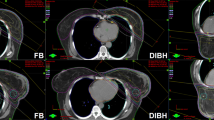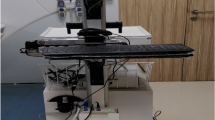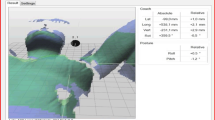Abstract
Background
This study aims to evaluate the reduction of cardiac radiation dose and volume with deep inspiration breath hold (DIBH) technique compared to free breathing (FB) in patients with left-sided breast cancer. The study also aims to evaluate whether the benefits of DIBH vary in patients who had whole breast radiotherapy (RT) after breast-conserving surgery (BCS) and those who had chest wall RT post-mastectomy (M).
Methods
FB and DIBH plans were generated for 15 consecutive post-BCS patients and 17 post-M patients who underwent RT with DIBH using varian real-time position management (RPM) system. Cardiac shields were used in all post-BCS plans, provided that clinical treatment volume coverage was not compromised, while chest wall coverage took priority in post-M plans. The prescribed dose was 50 Gy in 25 fractions for the whole breast or the chest wall. Parameters of interest were cardiac V5, mean LAD dose, maximum LAD dose, and mean heart dose. The impact of DIBH was compared in post-BCS and post-M patients using paired t tests. To gauge clinically meaningful outcome, the proportion of patients with V5 < 5 % and mean cardiac dose <2 Gy were compared using McNemar’s test.
Results
DIBH decreased V5 by an absolute 4.5 % (2.3 vs. 6.8 %; p < 0.0001) in post-M group, and by an absolute 2.4 % (1.3 vs. 3.7 %; p = 0.0028) in post-BCS group. DIBH decreased the mean heart dose by 107.0 cGy (127.4 vs. 234.4 cGy; p = 0.0002) in post-M group, and by 58.9 cGy (82.2 vs. 141.1 cGy; p = 0.0012) in post-BCS group. DIBH decreased mean LAD by 1201.6 cGy (670 vs. 1872.5 cGy; p = 0.0006) in post-M group, and by 799.0 cGy (425.3 vs. 1224.3 cGy; p = 0.0003) in post-BCS group. DIBH also decreased max LAD dose by 1244.3 cGy (2776.0 vs. 4020.3 cGy; p = 0.0014) in post-M group, and by 1856.3 cGy (1898.7 vs. 3754.9 cGy; p = 0.0005) in post-BCS group. In post-BCS group, cardiac V5 < 5 % was achieved in 10/15 (67 %) FB patients, and in 15/15 (100 %) DIBH patients (p = 0.002), and mean heart dose <2 Gy was achieved in 12/15 (80 %) FB patients and in 15/15 (100 %) DIBH patients (p < 0.001). This compares with post-M group, in which V5 < 5 % was achieved in 6/17 (35 %) FB patients and in 16/17 (94 %) DIBH patients (p = 0.05), and mean heart dose <2 Gy was achieved in 7/17 FB (41 %) an 16/17 DIBH patients (94 %) (p = 0.03).
Conclusion
The results of this study suggest that there is considerable reduction in cardiac exposure in most patients with DIBH compared to FB, although less reduction is observed in the post-BCS patients. The use of cardiac shields and collimators/gantry adjustments, more readily applicable for post-BCS cases, may limit the additional benefits of DIBH. In an environment where DIBH availability is limited, the result of this study supports the preferential use of DIBH in post-M patients over post-BCS patients.
Similar content being viewed by others
References
Darby SC, McGale P, Correa C, Taylor C, Arriagada R, Clarke M, Cutter D, Davies C, Ewertz M, Godwin J, et al. Effect of radiotherapy after breast-conserving surgery on 10-year recurrence and 15-year breast cancer death: meta-analysis of individual patient data for 10,801 women in 17 randomised trials. Lancet. 2011;378(9804):1707–16.
McGale P, Taylor C, Correa C, Cutter D, Duane F, Ewertz M, Gray R, Mannu G, Peto R, Whelan T, et al. Effect of radiotherapy after mastectomy and axillary surgery on 10-year recurrence and 20-year breast cancer mortality: meta-analysis of individual patient data for 8135 women in 22 randomised trials. Lancet. 2014;383(9935):2127–35.
Darby SC, McGale P, Taylor CW, Peto R. Long-term mortality from heart disease and lung cancer after radiotherapy for early breast cancer: prospective cohort study of about 300,000 women in US SEER cancer registries. Lancet Oncol. 2005;6(8):557–65.
Paszat LF, Mackillop WJ, Groome PA, Schulze K, Holowaty E. Mortality from myocardial infarction following postlumpectomy radiotherapy for breast cancer: a population-based study in Ontario, Canada. Int J Radiat Oncol Biol Phys. 1999;43(4):755–62.
Harris EE. Cardiac mortality and morbidity after breast cancer treatment. Cancer Control J Moffitt Cancer Center. 2008;15(2):120–9.
Darby SC, Ewertz M, McGale P, Bennet AM, Blom-Goldman U, Bronnum D, Correa C, Cutter D, Gagliardi G, Gigante B, et al. Risk of ischemic heart disease in women after radiotherapy for breast cancer. New Engl J Med. 2013;368(11):987–98.
McIntosh A, Shoushtari AN, Benedict SH, Read PW, Wijesooriya K. Quantifying the reproducibility of heart position during treatment and corresponding delivered heart dose in voluntary deep inhalation breath hold for left breast cancer patients treated with external beam radiotherapy. Int J Radiat Oncol Biol Phys. 2011;81(4):e569–76.
Borst GR, Sonke JJ, den Hollander S, Betgen A, Remeijer P, van Giersbergen A, Russell NS, Elkhuizen PH, Bartelink H, van Vliet-Vroegindeweij C. Clinical results of image-guided deep inspiration breath hold breast irradiation. Int J Radiat Oncol Biol Phys. 2010;78(5):1345–51.
Stranzl H, Zurl B: Postoperative irradiation of left-sided breast cancer patients and cardiac toxicity. Does deep inspiration breath-hold (DIBH) technique protect the heart? Strahlentherapie und Onkologie 2008;184(7):354–358.
Korreman SS, Pedersen AN, Aarup LR, Nottrup TJ, Specht L, Nystrom H. Reduction of cardiac and pulmonary complication probabilities after breathing adapted radiotherapy for breast cancer. Int J Radiat Oncol Biol Phys. 2006;65(5):1375–80.
Bovelli D, Plataniotis G, Roila F, Group EGW. Cardiotoxicity of chemotherapeutic agents and radiotherapy-related heart disease: ESMO clinical practice guidelines. Ann Oncol Off J Eur Soc Med Oncol. 2010;21(Suppl 5):v277–82.
Amir E, Seruga B, Niraula S, Carlsson L, Ocaña A. Toxicity of adjuvant endocrine therapy in postmenopausal breast cancer patients: a systematic review and meta-analysis. J National Cancer Inst. 2011;103(17):1299–309.
Wang W, Purdie TG, Rahman M, Marshall A, Liu FF, Fyles A. Rapid automated treatment planning process to select breast cancer patients for active breathing control to achieve cardiac dose reduction. Int J Radiat Oncol Biol Phys. 2012;82(1):386–93.
Nissen HD, Appelt AL. Improved heart, lung and target dose with deep inspiration breath hold in a large clinical series of breast cancer patients. Radiother Oncol. 2013;106(1):28–32.
Remouchamps VM, Vicini FA, Sharpe MB, Kestin LL, Martinez AA, Wong JW. Significant reductions in heart and lung doses using deep inspiration breath hold with active breathing control and intensity-modulated radiation therapy for patients treated with locoregional breast irradiation. Int J Radiat Oncol Biol Phys. 2003;55(2):392–406.
Yeung R, Conroy L, Long K, Walrath D, Li H, Smith W, Hudson A, Phan T. Cardiac dose reduction with deep inspiration breath hold for left-sided breast cancer radiotherapy patients with and without regional nodal irradiation. Radiat Oncol. 2015;10(1):1.
Whelan TJ, Olivotto IA, Parulekar WR, Ackerman I, Chua BH, Nabid A, Vallis KA, White JR, Rousseau P, Fortin A, et al. Regional nodal irradiation in early-stage breast cancer. New Engl J Med. 2015;373(4):307–16.
Poortmans PM, Collette S, Kirkove C, Van Limbergen E, Budach V, Struikmans H, Collette L, Fourquet A, Maingon P, Valli M, et al. Internal Mammary and Medial Supraclavicular Irradiation in Breast Cancer. New Engl J Med. 2015;373(4):317–27.
Author information
Authors and Affiliations
Corresponding author
Ethics declarations
Conflict of interest
The authors declare that they have no conflict of interest.
About this article
Cite this article
Lin, A., Sharieff, W., Juhasz, J. et al. The benefit of deep inspiration breath hold: evaluating cardiac radiation exposure in patients after mastectomy and after breast-conserving surgery. Breast Cancer 24, 86–91 (2017). https://doi.org/10.1007/s12282-016-0676-5
Received:
Accepted:
Published:
Issue Date:
DOI: https://doi.org/10.1007/s12282-016-0676-5




